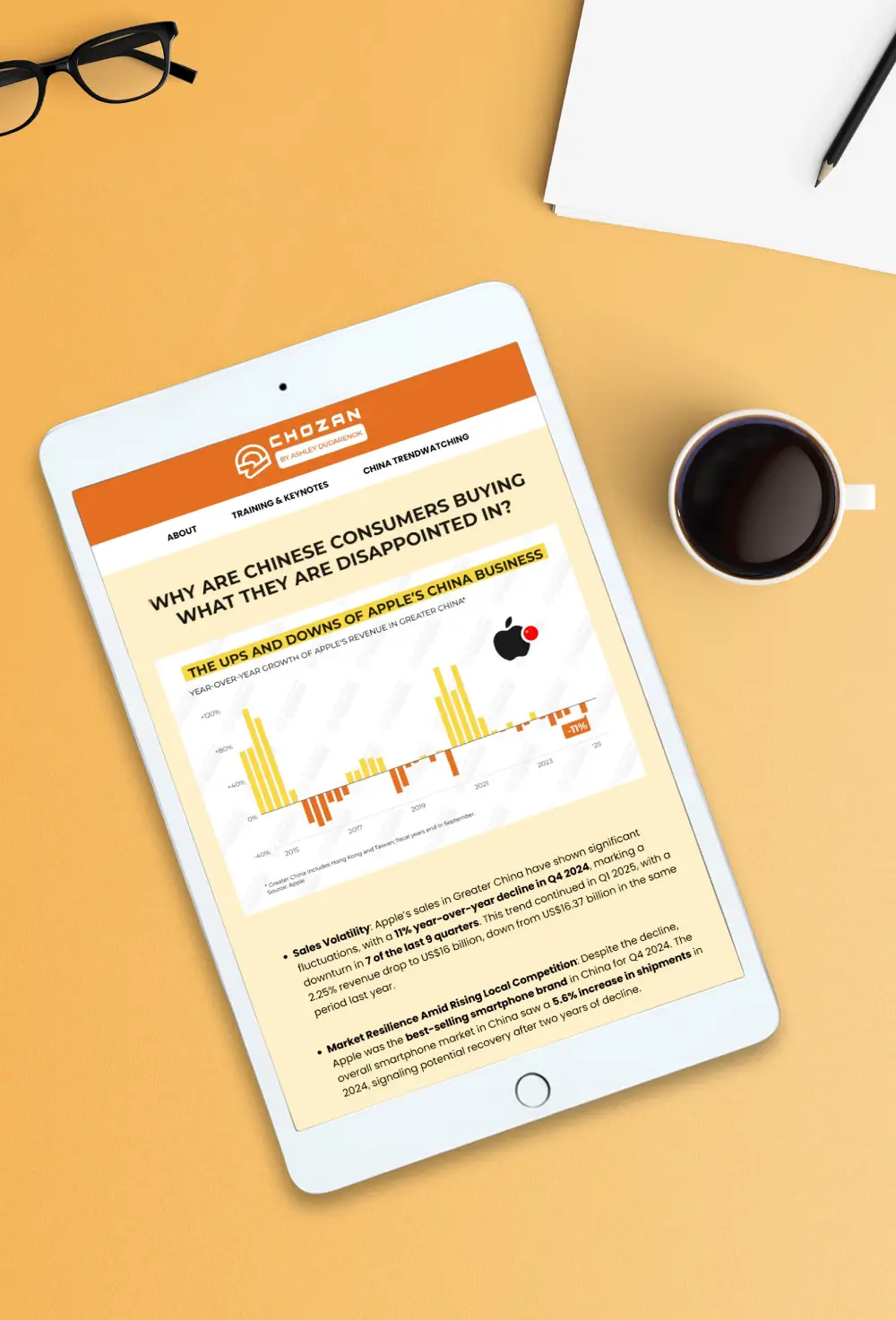CONTENT

By: Ashley Dudarenok
Updated:
China’s consumer market in 2025 is vast, dynamic, and evolving in surprising ways. With retail sales reaching nearly ¥48.8 trillion ($6.8 trillion) in 2024, it’s one of the world’s largest consumer markets – but it’s not one homogeneous block.
Understanding Chinese consumers means appreciating critical differences between urban and rural shoppers, generational shifts in attitudes, and the digital-first lifestyle that now defines shopping habits. It also requires recognizing the rise of local cultural pride in brand choices and a post-pandemic focus on value and experiences over status.
Being aware of these nuances is essential for international brands, marketers, and startups looking to succeed in China. Below, we break down five key insights to help you understand Chinese consumer behavior in 2025.
China’s economy is stable but under pressure. GDP grew 5% in Q1 2025, the same as in 2024, yet household finances tell a different story. Per capita disposable income rose just 2.1% in Q2, the lowest in five years, while household deposits surged by 10.77 trillion yuan in the first half of 2025. Families are saving more, despite record-low deposit rates, reflecting deep concerns about job security, property values, and the future costs of healthcare and education.
77% of households report experiencing heavier financial pressure, particularly in urban areas. This has fueled a shift from impulsive spending to careful budgeting and price-sensitive decision-making. In wet markets, demand for vegetables priced under ¥5 increased from 32% in 2023 to 51.3% in 2025, indicating that everyday frugality now influences consumer habits.
At the same time, structural differences are widening:
E-commerce continues to rise, with 3.48 trillion yuan in online retail sales in Q1 2025 (+12.3% YoY). Offline retail is struggling: Mall vacancy rates have reached 18.7% nationwide, and foot traffic in first-tier malls has fallen 23.5%. Yet, experiential formats are rebounding — cultural tourism, live events, and “15-minute living circles” are helping to keep community commerce alive.
This macro backdrop sets the stage for the five key consumer behaviors that will drive the Chinese market in 2025.
Beyond individual spending choices, several key industries are emerging as the most powerful engines of growth in China’s consumer market. Together, they reveal how Chinese consumer behavior in 2025 is being reshaped by economic pressure, cultural confidence, and rapid technological adoption.
Shoppers are redefining value—not just through price, but through meaning, personalization, and emotional connection. Consumption is increasingly guided by experiences, identity, and innovation rather than simple product utility. From AI-driven retail to the booming pet economy, these shifts show how everyday behavior reflects broader market evolution.
As we explore these sectors below, each represents both a mirror and a driver of Chinese consumer behavior—illustrating how new technologies, social values, and lifestyle aspirations are converging to define China’s next decade of growth.
As e-commerce continues to grow, offline experiences are making a comeback. Over 52% of consumers increased their offline spending in 2025, particularly in cultural tourism, outdoor activities, and experiential retail, such as immersive restaurants and VR centers.
At the same time, “15-minute living circles” are reshaping neighborhoods, with community convenience stores, fitness centers, and fresh markets becoming the backbone of daily consumption. Events like Douyin’s “Downstairs Lifestyle Festival” show how local commerce is being revitalized with cultural and entertainment layers.
Why it matters: These sectors highlight the new growth drivers beyond traditional retail. Success in China increasingly depends on aligning with identity, emotion, and technology — not just price and product.
China now has more pets than children under age four. Pet spending has grown into a ¥30 trillion market, projected to reach ¥ 30 trillion by 2035. Consumers are shifting toward premium pet foods, smart devices such as health monitors, and high-quality grooming and veterinary services.
Emotional attachment is central: pet cafes report higher per-customer spending than some five-star hotels, as pets serve both companionship and “healing” functions.
China’s 280 million seniors are reframing aging from “being cared for” to “being seen.” Spending priorities include anti-aging treatments, smart healthcare devices, leisure travel, and educational opportunities for seniors.
Digital adoption is accelerating, with over 70% of seniors shopping online. This “second adolescence” of older consumers is creating one of the largest emerging markets globally.
Artificial intelligence has become a core driver of purchase journeys. During Double 11 in 2024, AI tools were used 1.5 billion times, resulting in a 25% reduction in delivery times.
Consumers now rely on AI shopping assistants for personalized recommendations, while C2M (customer-to-manufacturer) models allow buyers to influence product design. AI transforms commerce from “people seeking products” to “products understanding people,” shifting the balance of power in the market.
Eco-friendly consumption is now a form of social currency. Younger consumers bring reusable cups to cafes, track the carbon footprint of pet products, and proudly share sustainable purchases online.
More than 60% of consumers are willing to pay higher prices for environmentally friendly products, especially Gen Z, at nearly 90%. Green products succeed not only because of their function but also because they serve as cultural statements of sophistication and awareness.

In 2025, Chinese consumers are balancing a desire for high-quality experiences with increased price awareness. Years of rapid growth, a disruptive pandemic, and slower economic confidence have shifted priorities from “own more” to “live better.” Purchases are judged on how they enhance life — and whether they’re worth the money.
Spending is flowing toward services and activities that enrich daily life. McKinsey research shows education, travel, dining, and health services are high-growth priorities. Parents invest in tutoring and extracurriculars; professionals pay for gyms or healthy meal plans; families splurge on trips after years of restrictions.
Domestic tourism is booming — 548 million travel bookings in 2024 — and platforms like Trip.com saw double-digit revenue growth. Resorts, restaurants, and leisure spots are packed as people make up for lost time.
This doesn’t mean across-the-board spending. Many adopt a dual approach: trading up for priority items and trading down elsewhere. For example, a shopper may choose premium organic skincare but opt for a cheaper local coffee chain instead of daily Starbucks.
Consumers delay upgrades to big-ticket items, such as cars, electronics, and appliances, while still indulging in wellness, hobbies, and “small treats” that enhance their quality of life. Value-for-money is decisive — if something feels worth it, they’ll buy; if not, they’ll save or downgrade.
Post-pandemic thriftiness runs deep. Shoppers use e-commerce discounts, group-buying apps, and time purchases for major promotions. Viral “special forces travel” — ultra-budget trips with overnight trains and instant noodles — shows the willingness to sacrifice comfort for affordable experiences. Even affluent travelers cut costs selectively, such as dining outside hotels to save on meals.
Value now encompasses not only quality, but also safety and sustainability. Young consumers are willing to pay more for eco-friendly goods, energy-efficient appliances, and healthy products. Government rebate programs in 2024 encouraged millions to trade in old appliances for greener models.
Affordable luxury is another growth space: brands like Luckin Coffee and Mixue Ice Cream thrive by combining stylish image, app-based convenience, and low prices — offering daily indulgence without premium markups. International brands are adapting by offering smaller sizes or entry-level products to meet the “cheap chic” demand.
Status is increasingly measured in experiences rather than possessions. Travel, concerts, sports events, niche hobbies, and gourmet outings offer social currency. The “metaphysical economy” — encompassing everything from astrology to temple visits — is growing at a rate of around 10% annually, monetizing emotional fulfillment.
The pet economy, worth £75 billion and up 22% year-on-year, and the health and wellness sector, projected to hit £39 billion by 2030, reflect this shift toward lifestyle and well-being.
This mindset changes how brands compete. Consumers are willing to spend, but only when purchases align with their personal priorities, deliver clear value, or offer a memorable experience. Price sensitivity, selective splurging, and lifestyle relevance now decide market winners.

China’s population of 1.4 billion spans multiple generations, each shaped by different economic and cultural contexts. In 2025, the generational cohorts—especially Generation Z and Millennials—will display distinct consumer behaviors that marketers must grasp.
Younger Chinese consumers are transforming markets with their digital nativity and values, while older generations still hold significant spending power (and often different preferences).
Here’s a look at how Gen Z, Millennials, Gen X, and Boomers differ:
China’s Generation Z (born 1995–2009) is becoming a major consumer force. They make up 19% of the population (about 265 million people) and shape trends far beyond their size. Almost all are on smartphones, and e-commerce with cashless payments is second nature.
They spend more time online than any other group—29% use their devices over six hours a day for shopping, socializing, and entertainment. Key platforms include WeChat, Douyin, Bilibili, and Red Note, where users discover brands and influencers.
Unlike older generations, Chinese Gen Z places a premium on individualism, self-expression, and emotional experiences. They don’t just buy products for functionality – they seek brands that align with their identity and values.
According to consumer experts, young Chinese increasingly “don’t merely pay for products; they pay for their lives,” seeking meaning and self-expression in their purchases.
This plays out in several ways:
Millennials, including those born in the 1980s and 1990s, are in their peak earning years and drive almost a quarter of China’s total consumption. Many have families, which shape their priorities toward stability and quality.
Many millennials grew up during China’s rapid economic boom and the arrival of global luxury brands. In Tier 1 and Tier 2 cities, status symbols such as iPhones, designer handbags, and upscale dining remain popular. A sub-group known as “spicy moms” continues investing in fashion and premium kids’ products, helping luxury sales double pre-pandemic levels by 2021.
While material goods matter, this generation increasingly values personal well-being and quality of life. The “lying flat” trend reflects a desire to step away from intense career competition and focus on personal growth. Spending on travel, family activities, wellness retreats, and personal development is rising, with brands offering experiential value gaining loyalty.
Urban millennials are affected by high housing costs, rising education expenses for their children, and job market uncertainty. Many now opt for high-quality local brands over expensive imports, as they offer better value. Delaying big purchases, they respond well to loyalty programs, targeted discounts, and bundled offers that maximize their spending power.
Older generations in China — Generation X (born 1965–1980) and Boomers (born before 1965) — hold substantial spending power. Many hold senior leadership roles, own valuable properties, and have benefited from decades of rapid economic growth. They remain an influential yet often under-targeted consumer group.
Generational differences shape not only what consumers buy but also how they discover, evaluate, and pay for it. Brands that tailor messaging, channels, and offerings to each group’s values and capabilities can unlock growth across multiple age segments, rather than focusing only on the youth market or affluent urban core.
In 2025, China’s consumer market isn’t just digital — it’s an integrated, mobile-first ecosystem where discovery, decision-making, payment, and delivery happen inside connected online environments. This digital-first mindset influences how quickly trends spread, how consumers evaluate products, and how brands must operate to remain relevant.
Here are the standout aspects of this digital behavior trend:
With 1.1 billion internet users (78.6% of the population) and almost universal smartphone access, a product can go from unknown to nationwide bestseller in days. Viral content on Douyin or RedNote doesn’t just drive awareness — it can trigger millions of purchases overnight, as payment, ordering, and delivery are just one tap away.
This scale turns digital platforms into both mass media and instant transaction channels, collapsing the gap between marketing and sales.
Online retail sales hit ¥15.52 trillion ($2.15 trillion) in 2024, accounting for 26.8% of total retail sales. Almost 90% of internet users shop online regularly, encompassing every category, from low-cost daily essentials to high-end luxury goods. Marketplaces like Taobao/Tmall, JD.com, and Pinduoduo give shoppers in major cities and remote towns equal access.
Because online shopping offers range, price comparison, and delivery speed unmatched by offline retail, consumers increasingly evaluate all purchases — even offline ones — through an e-commerce lens first.
Over 1 billion people use WeChat Pay and Alipay, and QR codes are accepted from luxury malls to street vendors. This ubiquity means that when consumers see a product online, they can act instantly — no wallet, no card, no delay.
The payment step is no longer a barrier to progress. This shortens the decision cycle and encourages impulse purchases, especially in live-stream sales and social feeds.
Platforms like Douyin and Kuaishou blur the line between content and commerce. 71% of viewers make purchases after watching product videos or live streams. The best-selling hosts mix product demos with entertainment, creating high-trust, high-conversion environments.
Entertainment keeps users engaged longer, giving brands more time to influence decisions. Shopping becomes an emotional, social activity rather than a purely functional one.
Brands increasingly invest in private traffic — direct customer communities on WeChat, brand apps, or membership programs. These channels bypass the unpredictability of public platform algorithms and allow repeated, personalized offers.
Customers stay longer in the brand’s ecosystem, increasing repeat purchase rates and reducing reliance on paid ads.
Over 76% of rural users and 70% of seniors shop online. Pandemic-era onboarding, combined with “elder-friendly” app interfaces, has made digital commerce accessible far beyond urban Gen Z and millennials. Digital strategies now reach every major demographic, making online commerce the unifying channel across China.
WeChat, Alipay, Taobao, and Douyin dominate digital life, integrating messaging, payments, bookings, and shopping. Consumers can complete the entire purchase journey without leaving these platforms. Platform loyalty reduces brand discovery through search or offline ads. If you’re not embedded in these ecosystems, you’re invisible to large portions of the market.
Same-day and next-day delivery are standard, with Meituan and Ele.me offering 30-minute service for food and groceries. Online-to-offline (O2O) options let users pay in advance and receive the service or product in person.
This speed conditions consumers to expect near-instant fulfillment, making slow brands less competitive even if their products are superior.
Digital-first behavior condenses the path from awareness to purchase into minutes, driven by mobile payments, social commerce, and expedited delivery. With most consumer activity happening inside a few super-app ecosystems, brands must integrate into these environments or risk losing visibility and relevance.

Economic pressures are driving consumers to stretch resources and seek maximum value. Instead of downgrading entirely, people are adopting smarter, frugal strategies.
Why it matters: This behavior reflects adaptation, not decline. Consumers are still spending — but with sharper calculations and a focus on cost-effectiveness.
Brand takeaways:
China’s urban centers and rural areas form two distinct consumer markets, but the gap between them is narrowing. Cities like Beijing, Shanghai, and Shenzhen have led the way in consumer spending, driven by higher incomes and mature retail options. Rural consumers once had lower incomes and limited access, but by 2025, rural consumption was rising faster than urban consumption.
In 2024, retail sales in China’s rural areas grew 4.3% year-on-year, outpacing the 3.4% growth in urban areas. This trend reflects government-led rural revitalization policies and faster income growth in rural areas.
In fact, rural household incomes jumped 6.6% in 2024, significantly higher than the 4.5% rise for urban residents. The result is stronger spending power in the countryside, narrowing the traditional urban-rural gap.
Over the past decade, rural Chinese have steadily gained wealth. From 2013 to 2023, rural retail sales grew at an average annual rate of 8.1%, nearly a full percentage point higher than urban retail growth.
While urban China still accounts for the majority of consumption, a growing rural middle class means 100 million+ new potential customers entering the market as incomes rise and lifestyles modernize.
One reason rural shoppers now spend more is better access to goods and services. In 2024, the government upgraded thousands of township shopping centers and tens of thousands of village convenience stores, making quality products available locally.
Logistics networks have expanded deep into villages—over 340,000 village-level delivery stations help solve the “last mile” problem.
Rural residents no longer have to travel to cities for high-quality items; local supermarkets and e-commerce platforms can deliver goods directly to their doorstep. This improved infrastructure is fueling rural consumption across categories from food to appliancesen.people.cnen.people.cn.
By December 2024, rural China had 313 million internet users. Rural online retail sales hit ¥2.5 trillion ($350 billion) in 2023—13 times the 2014 level—and grew 6.4% in 2024.
More than 76% of rural internet users shop online, and 71% of short-video viewers have made a purchase after watching live streams. Digital platforms have become the main gateway to shopping for many rural consumers.
In mid-2025, the consumer confidence index stood at 88, well below the 2021 level of 127. Urban residents, particularly in Tier 1 and Tier 2 cities, are more focused on saving. Rural and smaller-city residents are generally more optimistic, thanks in part to lower living costs and government support.
Generation Z in third- and fourth-tier cities is the most confident group, while low-income urban millennials face more financial constraints.
Rural and lower-tier city consumers are now a significant source of growth, offsetting slower spending in top-tier urban centers. Rising incomes, better infrastructure, and digital integration mean brands can no longer focus solely on big cities. Markets once considered peripheral are becoming essential to long-term strategy.
China’s consumer market is undergoing rapid changes. Slower income growth, record household savings, and shifting attitudes toward frugality, identity, and experiences make it harder than ever to decode what shoppers really want. At the same time, new forces like the pet economy, AI-driven consumption, and Guochao brands are reshaping entire industries.
If you want to go beyond headlines and truly understand these changes, ChoZan can help:
In 2025, China introduced targeted consumer loan interest subsidies, covering up to a 1% rate reduction on purchases and services, to incentivize spending in key sectors such as tourism and dining.
Despite economic headwinds, China remains the world's second-largest consumer market, and by around 2030, over 500 million people are projected to join the middle- or upper-income classes.
Consumer confidence remains subdued, with urban sentiment particularly cautious. However, retail sales are picking up, especially in food, EVs, and health products.
Key growth areas include food and beverage, electric vehicles (which account for nearly 50% of new car sales), and leisure travel—some of which have even surpassed pre-pandemic numbers.
Early estimates place the influencer economy at billions of renminbi. While dated, this scale reflects long-standing strength in KOL-led consumption.
Originally seen post-lockdown, revenge buying—where consumers splurge to compensate for past restrictions—has become less dominant, but it still serves as a cultural reference for rebound spending dynamics.
Chinese consumers are increasingly valuing sustainable packaging, with global data showing that 82% would be willing to pay more for eco-friendly options—led by Gen Z at 90%.
The 2025 China International Consumer Products Expo showcased AI, cultural heritage brands, and hybrid online-offline models, highlighting how exhibitions drive smart and cultural purchases.
The initiative has elevated domestic innovation in EVs, robotics, and green tech—boosting consumer trust in homegrown advanced products.
Yes—beyond luxury, today’s Chinese consumers emphasize craftsmanship, emotional storytelling, and value retention over foreign brand prestige.
By subscribing to Ashley Dudarenok’s China Newsletter, you’ll join a global community of professionals who rely on her insights to navigate the complexities of China’s dynamic market.
Don’t miss out—subscribe today and start learning for China and from China!

5 Innovative Live Streaming Platforms in China


8 Photo-Sharing Alternatives to Pinterest in China
Ashley Dudarenok is a leading expert on China’s digital economy, a serial entrepreneur, and the author of 11 books on digital China. Recognized by Thinkers50 as a “Guru on fast-evolving trends in China” and named one of the world’s top 30 internet marketers by Global Gurus, Ashley is a trailblazer in helping global businesses navigate and succeed in one of the world’s most dynamic markets.
She is the founder of ChoZan 超赞, a consultancy specializing in China research and digital transformation, and Alarice, a digital marketing agency that helps international brands grow in China. Through research, consulting, and bespoke learning expeditions, Ashley and her team empower the world’s top companies to learn from China’s unparalleled innovation and apply these insights to their global strategies.
A sought-after keynote speaker, Ashley has delivered tailored presentations on customer centricity, the future of retail, and technology-driven transformation for leading brands like Coca-Cola, Disney, and 3M. Her expertise has been featured in major media outlets, including the BBC, Forbes, Bloomberg, and SCMP, making her one of the most recognized voices on China’s digital landscape.
With over 500,000 followers across platforms like LinkedIn and YouTube, Ashley shares daily insights into China’s cutting-edge consumer trends and digital innovation, inspiring professionals worldwide to think bigger, adapt faster, and innovate smarter.
Please check your email and confirm your subscription.

Please check your email and confirm your subscription.

Please check your email and confirm your subscription.